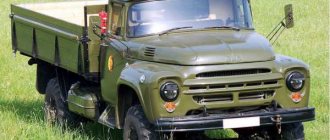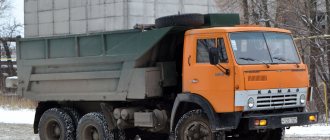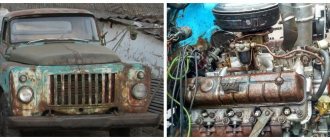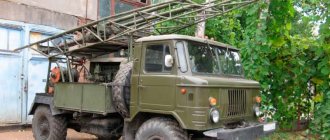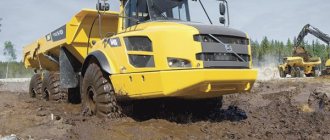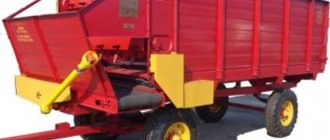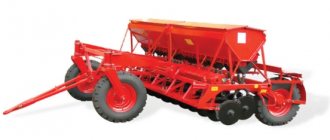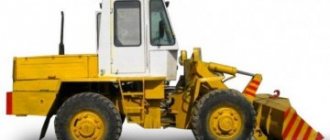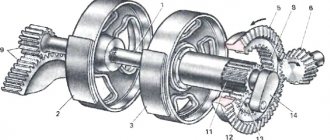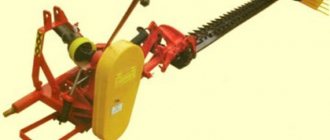- You might be interested
- Purpose
- Technical characteristics of the dump truck Engine
- More information on the website
- Dump truck ZIL-130
- General information
- Engine
- History of development
Dump truck ZIL-130: technical characteristics, price
ZIL-130 is the first civilian dump truck of the brand, produced back in the USSR. Initially, the equipment was created for military needs. The cars were then adapted for civilian use. ZIL-130 or simply “Kolkhoznik” has become one of the most popular domestic medium-tonnage vehicles. Today, the car maintains its position in the market due to its low cost and quick payback.
ZIL-130: history
Before entering public roads, the ZIL-130 has come a long way from development and testing to the release of the first pilot batch. The first steps towards creating a car were taken in 1957. It took Soviet engineers five years and titanic efforts to match the car's power with its performance characteristics and select a suitable power unit.
The first experimental batch of ZIL-130 rolled off the manufacturer's assembly line in 1962. Cars received user recognition only in 1963. Finally, in 1964, mass production of cars began. The production of ZIL-130 continued until 2010 at the Ural Automotive Plant.
Technical characteristics of ZIL-130 dump truck
The long process of selecting a power unit and performance indicators was not in vain for the ZIL-130. The world was presented with a new machine, which earned a diploma at an international exhibition and gained popularity among a wide range of users from the industrial and agricultural sectors.
Engine
ZIL-130 dump trucks use a factory power unit with a V-shaped arrangement of eight cylinders. The carburetor four-stroke engine produces 150 hp. maximum power. The crankshaft rotation speed reaches 3200 rpm. The engine reaches its maximum useful torque at 402 Nm.
The engine displacement is 5996 cm3. The engine cylinder diameter is 100 mm, the piston stroke in the cylinder is 95 mm. The compression ratio stopped at 6.5. The power supply system is a carburetor. The engine's needs are provided by the supply of A-76 fuel from fuel tanks with a volume of 175 liters.
Transmission
ZIL-130 dump trucks are equipped with a standard five-speed manual transmission. The clutch is a dry single-plate clutch. The drive is distributed to the rear axle, the front axle is steering. Wheel formula - 4x2. The standard tire size is 260x508. The maximum speed on paved roads is 90 km/h.
The standard ZIL-130 spring suspension was used in fourth-generation GAZ vehicles. Hydraulic shock absorbers are used on the front axle, telescopic shock absorbers are used on the rear axle. The pneumatic braking system operates on drum mechanisms.
Body size ZIL-130 dump truck
- length - 6675 mm;
- front wheel track - 1800 mm;
- rear wheel track - 1790 mm;
- cabin roof height - 2400 mm;
- height along the sides of the cargo platform - 2050 mm;
- wheelbase - 3800 mm;
- tilt angle - 38 degrees;
- turning diameter - 14 m;
- curb weight - 5100 kg;
- load capacity - 9000 kg;
- total weight - 14,100 kg;
- distribution to the front axle - 4200 kg;
- distribution to the rear axle - 9900 kg.
Body volume ZIL-130 dump truck
- tipper platform area - 8.7 m2;
- dumping platform volume - 5 m3;
- volume with extension sides - 7.8 m3;
- platform elevation angle - 50 degrees;
- unloading direction - back, right, left;
- platform dimensions - 2325x3752 mm.
Get an advantageous offer from direct suppliers:
You might be interested
spectehnika-info.ru
technical characteristics of the engine, compressor, load capacity, weight, dimensions, modifications
distant 60s from the assembly line of the automobile plant named after. Stalin produced the first ZIL-130, which is still in production, but under the name AMUR 53131.
The technical characteristics of the ZIL-130 dump truck were modern for that time.
This is the first car in the series with power steering and a synchronized gearbox.
Technical characteristics of the dump truck
The technical characteristics of the ZIL-130 car exceeded all expectations. A windshield washer appeared, the engine was heated before starting, and the cabin became a three-seater cabin. The car has become more comfortable.
Engine
The engine on the ZIL-130 is a v-shaped, eight-cylinder, 4-stroke “HORSE”. The working volume of the ZIL-130 engine is almost 6 liters, which, given its rather massive dimensions, is very economical.
Initially, the engine was a carburetor type, the overhead valve engine was intended for diesel fuel, but after 10 years of operation they began producing it for natural gas.
Table 1 - Technical characteristics of the ZIL-130 engine
| Name | ZIL-130 |
| Location | Longitudinal, front |
| Supply system | Carburetor |
| Cylinders, pcs. | 8 |
| Valves, pcs. | 2 |
| Volume, l | 5,99 |
| Power, hp | 150 |
| Rotation speed, rpm. | 3200 |
| Cooling | Liquid-air |
Improved synchronized rear-wheel drive gearbox (Gearbox) ZIL-130 with helical gears of constant mesh. Torque is transmitted to the rear axle, which provides more effective traction on asphalt roads or unpaved surfaces.
Table 2 — ZIL-130 gearbox design
| Gearbox | Mechanical |
| Number of speeds | 5 |
| Drive unit | Rear wheel drive |
Depending on the modification, there were bodies with side and rear unloading. The height of the body was the same as the height of a railway car, which simplified loading and unloading of goods.
The volume of the ZIL-130 body is 5 cubic meters, and the platform area is 8.7 square meters. Due to the fact that the body volume of the ZIL-130 dump truck is quite large, it was sometimes used in agriculture, for transporting workers.
Brake system
Front, rear and parking brakes are standard, shoe, drum type. They are driven by pneumatics.
MTZ 82 technical characteristics: description, prices, video.
Tatra 815 owner reviews can be read by clicking on the link.
Compressor
All the air is in a special cylinder under pressure, which is produced by the ZIL-130 compressor. The compressor efficiency on the ZIL-130 is 220 l/min. at 2000 rpm.
Power supply
Electrical equipment ZIL-130 is single-wire. Power is supplied from a 12 volt battery at a current of 90 A/h.
Dimensions and load capacity
Figure - Drawing of overall dimensions of the ZIL-130 truck
Table 3 describes the dimensions of the dump truck.
Table 3 - Dimensions of ZIL-130
| Length, mm | 6675 |
| Width, mm | 2500 |
| Height, mm | 2400 |
| Wheelbase, mm | 3800 |
The curb weight of the ZIL-130 is 9,360 tons, and the weight of the unloaded heavyweight ZIL-130 is 4.3 tons. The carrying capacity of the ZIL-130 dump truck varied depending on the model and dimensions of the cargo.
Initially, the maximum carrying capacity was 4 tons, but then reached 6 tons. The maximum load on the front axle is 2.625 tons, and on the rear axle - 7.9 tons, respectively.
Truck modifications
A few years later, the plant produced modifications of the ZIL-130. A total of 5 types were produced:
- ZIL-130A – onboard tractor;
- 130B – dump truck;
- 130V – truck tractor;
- 130W – with reinforced rear axle;
- ZIL-130G – long-wheelbase flatbed with a platform.
The latter worked with a trailer.
Technical characteristics of the truck crane
Photo of a truck crane based on ZIL-130.
The KS-2561D and KS-2561DA truck cranes were designed on the basis of the ZIL-130 dump truck chassis. The modified chassis is cable-type with a fixed linkage and folding outriggers.
This “BABID” is equipped with a double-row roller or ball bearing mechanism. The boom, due to its solidity, is lattice, because it does not have a retractable function.
Table 4 - Technical characteristics of truck cranes based on ZIL 130 KS-2561D and KS-2561DA.
| Base car | ZIL-130 |
| Base chassis power, kW | 110 |
| Switch installation | — |
| main | fixed boom |
| replaceable | with extended boom, with extended boom and jib |
| Main boom length, m | 8 |
| Reach, m | 3,3-7 |
| Load capacity, t | 1,6 |
| Load lifting/lowering speed | 0,2-5,3 |
| Rotation speed, rpm | 0,3-2,5 |
| Length, m | 10,6 |
| Height, m | 3,65 |
| Width, m | 2,5 |
| Weight, t | 8,8 |
The advantage of truck cranes based on ZIL-130 is that the maximum boom lifting height is 15 meters. So this “Collos of Rhodes” easily lifts the load to the level of the 3rd - 4th floor.
Liebherr crane, description of the model range.
Read about the mini tractor Garden Scout T 12 reviews in the article by clicking on the link.
Do you want to learn how to make a homemade all-terrain vehicle on tracks with your own hands?
Released in 1957, the ZIL-130 became popular among trucks due to its reliability and versatility. And a large number of modifications made it possible to expand its use in rural, commercial and even military spheres.
More information on the website
spectechzone.com
130 - technical characteristics and features of the truck
Zil-130 first rolled off the production line in the 60s. Plant named after Stalin managed to produce a car with a synchronized gearbox, equipped with power steering. The new dump truck not only met expectations, but also exceeded them: a glass washer, a heated engine, a three-seater cab - all this was new. The Zil-130, whose technical characteristics were aimed at maximizing efficient operation, turned out to be so successful that it is still in production today. Only the name has changed - now it is “AMUR 53131”. What is special about this model and why did this truck become one of the most powerful in the Soviet Union? In this article we will look at this issue.
Engine
The V-shaped eight-cylinder 4-stroke engine ZIL-130 has an economical volume of about 6 liters. At first, the truck’s engine was carburetor-powered, but after 10 years of use, a model version with natural gas was launched. If it is gasoline, the fuel consumption of the ZIL-130 per 100 km is approximately 30 liters. In this case, you can use inexpensive A-72 or A-76 fuel. The technical nuances of the engine are shown in the table.
| Power scheme | Carburetor |
| Number of valves | 2 |
| Number of cylinders | 8 |
| Position | Front, longitudinal |
| Power in hp | |
| Volume in l. | 5.99 |
| Rotation in rpm | 3200 |
| Temperature reduction method | Air-liquid |
| Tank volume, l. | 176 |
| Maximum speed km/h | 90 |
Models have also been developed for cold climate zones with pre-heating.
Transmission
The synchronous rear-wheel drive gearbox is equipped with helical gears of constant clutch. Torque is supplied to the rear axle, as a result of which the ZIL-130 “Kolkhoznik” has better grip on dirt and asphalt roads.
| Switch box | Mechanics |
| Number of positions | 5 |
| Drive unit | Rear wheel drive |
Body Features
All types of body imply either rear unloading or unloading to the side. The dimensions of the body are as follows: the height is equal to the height of the railway car, which speeds up loading/unloading; platform area is 8.7 m2; The body volume of a standard ZIL-130 dump truck is 5 cubic meters. In Soviet times, the large size of the body, as well as the spacious ZIL cabin, made it possible to use the vehicle for transporting workers. See the table for body volume data.
| With installed sides | 7.8 m3 |
| Without sides | 5 m3 |
| Platform area | 8.7 m2 |
| Unloading directions | Straight and sideways |
| Climbing angle | 50 gr. |
| Platform size | 2325 by 3752 mm |
Rear loading Side loading
Hydraulics
The body lifting/lowering technology includes a 17 liter hydraulic fluid tank, a mechanical pump and a lifting hydraulic cylinder.
Load capacity and overall dimensions
The ZIL-130 dump truck initially had a load capacity of 4 tons; At present, the carrying capacity of the ZIL-130 vehicle has reached 6 tons. A maximum load of 2.625 tons is possible for the front axle, and 7.9 tons for the rear axle. In the table, we consider the general dimensions of this truck.
| Width (in millimeters) | 2500 |
| In height | 2400 |
| In length | 6675 |
| Wheel base | 3800 |
Additional characteristics and modifications
The brakes are of the shoe-drum type; operate using pneumatics. To operate the braking system, a compressor is used that fills the corresponding cylinder with compressed oxygen - the efficiency at 2 thousand revolutions is 220 l/m. The truck's electrical power comes from a battery. Voltage - 12 V; current - 90 A/h. Tire size (tires) - 260-508(P) R20.
For the automotive industry of the USSR, a fairly advanced steering system was used: a hydraulic booster with a double vane pump rotating from the crankshaft via a belt was then considered an innovative solution. To find out how much the ZIL-130 weighs, you need to determine the name of the specific model. The weight of the standard version is 4300 kg.
5 modifications of the car were developed:
- 130A - onboard tractor;
- 130B - dump truck, widely used in agricultural work;
- 130V - truck tractor;
- 130G - extended flatbed truck with a platform;
- 130W - with a reinforced rear axle, a distinctive feature.
Extended flatbed truck
Truck tractor
Dump Truck
Conclusion
The fact that the original model of the ZIL-130 car was developed back in Soviet times and is inferior in many respects to its modern counterparts does not in any way affect its popularity. The machine is used in the construction of houses and for the removal of household goods. The car has a standard weight (for example, the “Shorty” model weighs 2850 kg). The model is also in demand in agriculture, where convenience combined with low operating costs is an important factor.
naperevoz.ru
Engine
Over the years of production, various power units were installed on the car.
- ZIL-131. It had minimal differences from the ZIL-130 model. They mainly consisted of shielding electronic equipment. Otherwise, it was the same V-shaped eight with a displacement of 5969 cubic centimeters. It developed a power of 150 hp. s., which was clearly not enough for a heavier vehicle with a three-axle drive. It is precisely the lack of power that is responsible for the increase in fuel consumption from 32 to almost 50 liters per hundred kilometers.
- D-243. The engine-building base was not a strong point of the domestic automobile industry, and a tractor engine running on diesel fuel, developing only 81 hp. s., they began to install it rather out of despair. Fuel consumption dropped to 18 liters and became quite acceptable. But along with it, the already not outstanding dynamic characteristics of the car decreased.
- Some sources claim that the vehicle was standardly equipped with a YaMZ-236 engine. This information is not true. But the characteristics of this power unit correspond well to the general concept of the machine, and some enterprises engaged in similar modifications of equipment. As a result of an increase in power to 180 hp. s., and an increase of more than one and a half times, from 402 to 689 Nm, of torque, the car drove faster, and fuel consumption was 30 liters per hundred kilometers.
Transmission
Through a mechanical five-speed gearbox and a two-stage transfer case, the force was transmitted to three drive axles equipped with a tire pressure regulation system. The front axle was connected from the cab, for which a toggle switch was provided on the instrument panel. This design ensured high maneuverability, but due to the vehicle’s insufficient thrust-to-weight ratio and the not very successful selection of gear ratios, its capabilities could not be fully realized. Nevertheless, the car moved much more confidently off-road than dump trucks based on the ZIL-130.
Car prices
Since the lack of a developed road network is a problem in many regions not only of Russia, but also of the former Soviet republics, the ZIL-131 dump truck turned out to be in demand, despite its shortcomings. And although it is no longer produced, used equipment can still be bought today, and inexpensively. Prices for it range from 70 to 350 thousand rubles and depend on the technical condition of the car.
Similar materials
- Renault Magnum - the flagship among long-distance transport vehicles
- Renault Magnum - the flagship among long-distance transport vehicles
- Dump truck ZIL-130
- Dump truck ZIL-130
- GAZ-3302 "Gazelle"
- GAZ-3302 "Gazelle"
- Truck crane based on MAZ-5337
- Truck crane based on MAZ-5337
- Truck crane Ivanovets 25 tons
- Truck crane Ivanovets 25 tons
- Dump truck MAZ-5551 - the workhorse of a construction site
The MAZ-5551 dump truck is the workhorse of a construction site
. There is not much to say about this truck, since it is probably familiar to everyone, even to those who have only seen the truck in computer games. The ZIL-130 dump truck has lived for almost half a century on the domestic truck market and has recently ceased production, although there is a possibility that production will resume, as was the case after 1994 with its modifications.
Order dump bodies to ZIL
There are many companies that offer to purchase this product. But among all, “KropKuzov” stands out. Customers can buy not only standard products, but also make an individual order. During manufacturing, the specific application of the trailer must be taken into account. Haven't decided where to place your order yet? There is no need to waste time, because this company offers the most favorable purchasing conditions.
Anyone can order a dump body for Zil from the KropKuzov company; you just have to go to the company’s website. You need to know that the entire offered model range is constantly updated, complete modernization is taking place, and this is very important for the company’s reputation. The following requirements are taken into account during manufacturing:
- safety;
- load capacity;
- sound insulation;
- weight;
- design;
- maintainability.
Many production requirements indicate that the product offered is truly high quality and safe. Contact this company and purchase equipment worthy of attention.
Construction of the ZIL-130 dump truck
Over the entire history of development, more than 20 versions of the truck were produced. The main part of them was equipped with 8-cylinder engines with a V-shaped arrangement of elements. The 4-stroke engine on the hood of the truck produces 150 hp. at maximum speed. It is powered by a K-88AE carburetor. It is worth noting that export models do not use domestic engines, but foreign brands Perkins, Valmet, Leyland of varying power and design.
The ZIL-130 dump truck has a 4x2 wheel arrangement. It is controlled by a mechanical transmission. It is implemented with a 5-speed gearbox. Dry type single disc clutch. The rear wheels are driving, and the front pair is used for steering. The spring suspension complements the chassis. The front axle is equipped with hydraulic shock absorbers, and the rear axle uses telescopic elements.
Since the device is used as a dump truck, the ZIL-130 is equipped with a hydraulic system for lifting the body. The tank for the liquid used has a capacity of 17 liters. At the same time, the power take-off allows you to get up to 4.5 hp. The carrying capacity of the prototype was only 5 tons, however, during the modernization process this figure increased to 6 tons.
The truck uses hydraulic power steering. The truck's cabin is quite spacious and is designed for a driver and two passengers. It has comfortable seats, a heating system, and in older versions there were hatches for ventilation, which were eventually removed from the structure. A whole series of fire engines were built on the basis of the same design.
Welding, tape measure, installation: how Becem dump trucks are made
Such a list of tools - a welding machine, a tape measure, an assembly tool - is on the diagram for assembling dump truck bodies, which are made at the Becema plant in Krasnogorsk near Moscow. This plant celebrated its 85th anniversary, and I visited there.
Maniacs. They are maniacs, honestly. When I visited Betcema a month before the festive events (on Friday afternoon, by the way), it turned out that the plant was not at all going to stop production and close for the weekend! The management was on site until about ten o’clock in the evening (and periodically monitored the production process), work was in full swing in the workshops, and when we parted they told me: “Tomorrow, Saturday, we will come too. We need to give some of the cars to the customer.” Here it is, the difference between a private enterprise with a flexible schedule: “Saw, Shura, they are golden!”
Then, in my presence, they were filing an order for two dozen unusual dump trucks for Donaerodorstroy. In order to load properly without violating weight standards, the Donetsk team chose the exotic Volvo FMX 8×4 Tridem chassis (pronounced Tridem, as in Holland, where such vehicles are common). At the rear there is a three-axle bogie, and the last axle can “tuck in” and steer. Until now, only one small batch of Tridem coal tankers for Kuzbass has been manufactured in our country. Who would have thought that such an unusual layout would also appeal to the road workers of Rostov-on-Don!
I drove one of the finished trucks around the factory: thanks to the rear steering axle, it maneuvers well in narrow passages and overall leaves the feeling of a huge passenger car. The cabin is quiet, gears are switched imperceptibly by the I-Shift robot, and there are a lot of smart electronics (for example, it only allows you to crawl at low speed if the power take-off is turned on).
The name Becema stands for “Begemann + Zemmash”: in 1991, the company was bought by two families, Dutch and Russian. And initially the plant was called Standard-Beton: it was founded in 1932 and for a long time made reinforced concrete structures - for the Moscow-Volga canal, the metro, and even for the Ostankino TV tower. The scale of the enterprise through which the railway tracks pass is impressive: there is room to expand! The decision to reorganize Tsemmash (as the plant was called in the last Soviet years) into Betsema was made by the USSR Council of Ministers, and this is one of the first large enterprises to be privatized.
Betsema began with “barrel” tanks, which are still produced today, including simple single-axle ones and with Russian Tonar bridges. There are other products: grain trucks, road repair machines, and even exotic equipment for hydraulic fracturing.
But the basis of the range is dump trucks on European chassis. There are more and more of these in our country, but it is clear that superstructures must comply both in terms of accuracy of execution (no uneven seams!) and in quality. “Good bodies cannot be cheap: for ordinary dump trucks - around 20 thousand euros, for a rock climbing truck - 40 thousand,” comment Becema’s representatives.
And they are proud to be certified to produce bodies for the entire “Big Seven” European truck manufacturers. More precisely, already eights - because they started making bodies for “KAMAksors” (that’s what we call KAMAZs with Mercedes Axor cabs and other imported components). It’s clear why: “KAMAxors” are already close to foreign cars, and buyers want to see “foreign” bodies on them.
KAMAZ 6x6 of the new generation - also with a Becema body
Of course, the KAMAZ chassis is new to Becema and not everything is simple with them: let’s say, for an 8x4 four-axle vehicle, the vertical exhaust turned out to be bulky and located far from the cabin - which forced the front wall of the body to be made almost semicircular. But the advantage of custom tailoring lies in the fact that every non-standard chassis is approached creatively here, be it a Volvo Tridem or a KAMAxor.
At the same time, 80% of the steel at the plant is already of Russian origin: it is being transported en masse from NLMK, the Novolipetsk Iron and Steel Works, and they have begun to purchase it in Magnitogorsk. The standard thickness of the bottom of dump bodies is 8 mm, the sides are 5 mm.
The factory workers are especially proud of those same rock climbing trucks, huge mining dump trucks on the chassis of the same Volvo or MAN. They work in very harsh conditions, and drivers don’t particularly spare them. For example, it is considered normal after unloading to accelerate and slam the heavy tailgate against the edge of the body to shake off the remaining debris.
The bottom of the rocks is with counter deflection
So the bodies here are much more powerful (the floor is 12 mm, the sides are figure eight), the steel is special - Swedish Hardox, as evidenced by the stamps of the manufacturer SSAB. Such bodies have a molded structure without steel ribs (this saves 400-500 kg), and the bottom has a counter-deflection, that is, curved in the opposite direction for reinforcement. According to factory workers, in Russia there is simply no equipment yet that can bend metal of such thickness!
First, the bodies are boiled in tilters
The welding and assembly of each such body, called Format, is reminiscent of the manufacturing process of a ship. First, these bodies, like others, are cooked in huge tilters, turning around the longitudinal axis on a huge stand, then the workers pore around the “ships” with a welding machine and a tape measure... By the way, a giant visor in the front is a requirement of technical supervision: if the cabin is not covered by 100 %, the driver is obliged to leave the car during stripping operations and go to a safe distance, which leads to loss of time.
Welding by hand - slowly and very carefully
“Why is this quarry Volvo still standing here? I saw him a month ago!” — I was surprised when I arrived to celebrate the 85th anniversary of the plant. It turned out that the car was the same in appearance, but different in appearance: the one I saw in May had the serial number B13 (it is written large on the body), and this one was already B26. Such giants are bought by the Coal Company of Buryatia, but for the transportation not of coal, but of the empty rock lying on top - that same overburden.
Quarry Volvo FMXs with powerful rock bodies work in Buryatia
But spectacular and expensive sneakers occupy no more than 5% of production volume. In total, about 600 units of equipment were made here last year (400 of them were dump trucks), the current plan is to double the total output and, among other things, make a thousand dump trucks.
And for the 85th anniversary of the plant, vehicle No. 8500 came out of the workshop - the countdown dates back to 1991 (the number was probably slightly adjusted, but it looks beautiful). This is an ordinary MAN, one of those sold on trading floors, and in the assembly shop on the days of the celebration there were exclusively MAN chassis - both Polish-made and St. Petersburg-assembled. The fact is that Betsema recently concluded a three-year agreement with the Russian representative office of MAN, and from now on, without exception, all Manov dump trucks in our country will be equipped with bodies from Krasnogorsk.
The anniversary dump truck was the regular MAN TGS 6×4
But the factory workers are a little embarrassed about their workshops - they say, they are not as modern as the cars themselves. I can console you: when ten years ago I visited the plant of the famous German dump truck manufacturer Meiller in Munich, it turned out that its equipment was produced in low, antique buildings, among which there was even a wooden one. There, unlike Becema, I was not even allowed to photograph the production process.
And the conclusion is simple: in our country they not only assemble imported trucks, but also equip them with high-quality bodies en masse. So KAMAZ began to follow suit - and this is good news.
Technical characteristics of the ZIL-130 dump truck
- length - 6675 mm;
- front wheel track - 1800 mm;
- rear wheel track - 1790 mm;
- cabin roof height - 2400 mm;
- height along the sides of the cargo platform - 2050 mm;
- wheelbase - 3800 mm;
- tilt angle - 38 degrees;
- turning diameter - 14 m;
- curb weight - 5100 kg;
- load capacity - 9000 kg;
- total weight - 14,100 kg;
- distribution to the front axle - 4200 kg;
- distribution to the rear axle - 9900 kg.
Video about the ZIL-130 dump truck
technical characteristics of the engine, compressor, load capacity, weight, dimensions, modifications
distant 60s from the assembly line of the automobile plant named after. Stalin produced the first ZIL-130, which is still in production, but under the name AMUR 53131.
The technical characteristics of the ZIL-130 dump truck were modern for that time.
This is the first car in the series with power steering and a synchronized gearbox.
Technical characteristics of the dump truck
The technical characteristics of the ZIL-130 car exceeded all expectations. A windshield washer appeared, the engine was heated before starting, and the cabin became a three-seater cabin. The car has become more comfortable.
Engine
The engine on the ZIL-130 is a v-shaped, eight-cylinder, 4-stroke “HORSE”. The working volume of the ZIL-130 engine is almost 6 liters, which, given its rather massive dimensions, is very economical.
Initially, the engine was a carburetor type, the overhead valve engine was intended for diesel fuel, but after 10 years of operation they began producing it for natural gas.
Table 1 - Technical characteristics of the ZIL-130 engine
| Name | ZIL-130 |
| Location | Longitudinal, front |
| Supply system | Carburetor |
| Cylinders, pcs. | 8 |
| Valves, pcs. | 2 |
| Volume, l | 5,99 |
| Power, hp | 150 |
| Rotation speed, rpm. | 3200 |
| Cooling | Liquid-air |
Improved synchronized rear-wheel drive gearbox (Gearbox) ZIL-130 with helical gears of constant mesh. Torque is transmitted to the rear axle, which provides more effective traction on asphalt roads or unpaved surfaces.
Table 2 — ZIL-130 gearbox design
| Gearbox | Mechanical |
| Number of speeds | 5 |
| Drive unit | Rear wheel drive |
Depending on the modification, there were bodies with side and rear unloading. The height of the body was the same as the height of a railway car, which simplified loading and unloading of goods.
The volume of the ZIL-130 body is 5 cubic meters, and the platform area is 8.7 square meters. Due to the fact that the body volume of the ZIL-130 dump truck is quite large, it was sometimes used in agriculture, for transporting workers.
Brake system
Front, rear and parking brakes are standard, shoe, drum type. They are driven by pneumatics.
MTZ 82 technical characteristics: description, prices, video.
Tatra 815 owner reviews can be read by clicking on the link.
Compressor
All the air is in a special cylinder under pressure, which is produced by the ZIL-130 compressor. The compressor efficiency on the ZIL-130 is 220 l/min. at 2000 rpm.
Power supply
Electrical equipment ZIL-130 is single-wire. Power is supplied from a 12 volt battery at a current of 90 A/h.
Dimensions and load capacity
Figure - Drawing of overall dimensions of the ZIL-130 truck
Table 3 describes the dimensions of the dump truck.
Table 3 - Dimensions of ZIL-130
| Length, mm | 6675 |
| Width, mm | 2500 |
| Height, mm | 2400 |
| Wheelbase, mm | 3800 |
The curb weight of the ZIL-130 is 9,360 tons, and the weight of the unloaded heavyweight ZIL-130 is 4.3 tons. The carrying capacity of the ZIL-130 dump truck varied depending on the model and dimensions of the cargo.
Initially, the maximum carrying capacity was 4 tons, but then reached 6 tons. The maximum load on the front axle is 2.625 tons, and on the rear axle - 7.9 tons, respectively.
Truck modifications
A few years later, the plant produced modifications of the ZIL-130. A total of 5 types were produced:
- ZIL-130A – onboard tractor;
- 130B – dump truck;
- 130V – truck tractor;
- 130W – with reinforced rear axle;
- ZIL-130G – long-wheelbase flatbed with a platform.
The latter worked with a trailer.
Technical characteristics of the truck crane
Photo of a truck crane based on ZIL-130.
The KS-2561D and KS-2561DA truck cranes were designed on the basis of the ZIL-130 dump truck chassis. The modified chassis is cable-type with a fixed linkage and folding outriggers.
This “BABID” is equipped with a double-row roller or ball bearing mechanism. The boom, due to its solidity, is lattice, because it does not have a retractable function.
Table 4 - Technical characteristics of truck cranes based on ZIL 130 KS-2561D and KS-2561DA.
| Base car | ZIL-130 |
| Base chassis power, kW | 110 |
| Switch installation | — |
| main | fixed boom |
| replaceable | with extended boom, with extended boom and jib |
| Main boom length, m | 8 |
| Reach, m | 3,3-7 |
| Load capacity, t | 1,6 |
| Load lifting/lowering speed | 0,2-5,3 |
| Rotation speed, rpm | 0,3-2,5 |
| Length, m | 10,6 |
| Height, m | 3,65 |
| Width, m | 2,5 |
| Weight, t | 8,8 |
The advantage of truck cranes based on ZIL-130 is that the maximum boom lifting height is 15 meters. So this “Collos of Rhodes” easily lifts the load to the level of the 3rd - 4th floor.
Liebherr crane, description of the model range.
Read about the mini tractor Garden Scout T 12 reviews in the article by clicking on the link.
Do you want to learn how to make a homemade all-terrain vehicle on tracks with your own hands?
Released in 1957, the ZIL-130 became popular among trucks due to its reliability and versatility. And a large number of modifications made it possible to expand its use in rural, commercial and even military spheres.
More information on the website
spectechzone.com
130 - technical characteristics and features of the truck
Zil-130 first rolled off the production line in the 60s. Plant named after Stalin managed to produce a car with a synchronized gearbox, equipped with power steering. The new dump truck not only met expectations, but also exceeded them: a glass washer, a heated engine, a three-seater cab - all this was new. The Zil-130, whose technical characteristics were aimed at maximizing efficient operation, turned out to be so successful that it is still in production today. Only the name has changed - now it is “AMUR 53131”. What is special about this model and why did this truck become one of the most powerful in the Soviet Union? In this article we will look at this issue.
Engine
The V-shaped eight-cylinder 4-stroke engine ZIL-130 has an economical volume of about 6 liters. At first, the truck’s engine was carburetor-powered, but after 10 years of use, a model version with natural gas was launched. If it is gasoline, the fuel consumption of the ZIL-130 per 100 km is approximately 30 liters. In this case, you can use inexpensive A-72 or A-76 fuel. The technical nuances of the engine are shown in the table.
| Power scheme | Carburetor |
| Number of valves | 2 |
| Number of cylinders | 8 |
| Position | Front, longitudinal |
| Power in hp | |
| Volume in l. | 5.99 |
| Rotation in rpm | 3200 |
| Temperature reduction method | Air-liquid |
| Tank volume, l. | 176 |
| Maximum speed km/h | 90 |
Models have also been developed for cold climate zones with pre-heating.
Transmission
The synchronous rear-wheel drive gearbox is equipped with helical gears of constant clutch. Torque is supplied to the rear axle, as a result of which the ZIL-130 “Kolkhoznik” has better grip on dirt and asphalt roads.
| Switch box | Mechanics |
| Number of positions | 5 |
| Drive unit | Rear wheel drive |
Body Features
All types of body imply either rear unloading or unloading to the side. The dimensions of the body are as follows: the height is equal to the height of the railway car, which speeds up loading/unloading; platform area is 8.7 m2; The body volume of a standard ZIL-130 dump truck is 5 cubic meters. In Soviet times, the large size of the body, as well as the spacious ZIL cabin, made it possible to use the vehicle for transporting workers. See the table for body volume data.
| With installed sides | 7.8 m3 |
| Without sides | 5 m3 |
| Platform area | 8.7 m2 |
| Unloading directions | Straight and sideways |
| Climbing angle | 50 gr. |
| Platform size | 2325 by 3752 mm |
Rear loading Side loading
Hydraulics
The body lifting/lowering technology includes a 17 liter hydraulic fluid tank, a mechanical pump and a lifting hydraulic cylinder.
Load capacity and overall dimensions
The ZIL-130 dump truck initially had a load capacity of 4 tons; At present, the carrying capacity of the ZIL-130 vehicle has reached 6 tons. A maximum load of 2.625 tons is possible for the front axle, and 7.9 tons for the rear axle. In the table, we consider the general dimensions of this truck.
| Width (in millimeters) | 2500 |
| In height | 2400 |
| In length | 6675 |
| Wheel base | 3800 |
Additional characteristics and modifications
The brakes are of the shoe-drum type; operate using pneumatics. To operate the braking system, a compressor is used that fills the corresponding cylinder with compressed oxygen - the efficiency at 2 thousand revolutions is 220 l/m. The truck's electrical power comes from a battery. Voltage - 12 V; current - 90 A/h. Tire size (tires) - 260-508(P) R20.
For the automotive industry of the USSR, a fairly advanced steering system was used: a hydraulic booster with a double vane pump rotating from the crankshaft via a belt was then considered an innovative solution. To find out how much the ZIL-130 weighs, you need to determine the name of the specific model. The weight of the standard version is 4300 kg.
5 modifications of the car were developed:
- 130A - onboard tractor;
- 130B - dump truck, widely used in agricultural work;
- 130V - truck tractor;
- 130G - extended flatbed truck with a platform;
- 130W - with a reinforced rear axle, a distinctive feature.
Extended flatbed truck
Truck tractor
Dump Truck
Conclusion
The fact that the original model of the ZIL-130 car was developed back in Soviet times and is inferior in many respects to its modern counterparts does not in any way affect its popularity. The machine is used in the construction of houses and for the removal of household goods. The car has a standard weight (for example, the “Shorty” model weighs 2850 kg). The model is also in demand in agriculture, where convenience combined with low operating costs is an important factor.
naperevoz.ru
Dump truck ZIL-130: technical characteristics, price
ZIL-130 is the first civilian dump truck of the brand, produced back in the USSR. Initially, the equipment was created for military needs. The cars were then adapted for civilian use. ZIL-130 or simply “Kolkhoznik” has become one of the most popular domestic medium-tonnage vehicles. Today, the car maintains its position in the market due to its low cost and quick payback.
ZIL-130: history
Before entering public roads, the ZIL-130 has come a long way from development and testing to the release of the first pilot batch. The first steps towards creating a car were taken in 1957. It took Soviet engineers five years and titanic efforts to match the car's power with its performance characteristics and select a suitable power unit.
The first experimental batch of ZIL-130 rolled off the manufacturer's assembly line in 1962. Cars received user recognition only in 1963. Finally, in 1964, mass production of cars began. The production of ZIL-130 continued until 2010 at the Ural Automotive Plant.
Technical characteristics of ZIL-130 dump truck
The long process of selecting a power unit and performance indicators was not in vain for the ZIL-130. The world was presented with a new machine, which earned a diploma at an international exhibition and gained popularity among a wide range of users from the industrial and agricultural sectors.
Engine
ZIL-130 dump trucks use a factory power unit with a V-shaped arrangement of eight cylinders. The carburetor four-stroke engine produces 150 hp. maximum power. The crankshaft rotation speed reaches 3200 rpm. The engine reaches its maximum useful torque at 402 Nm.
The engine displacement is 5996 cm3. The engine cylinder diameter is 100 mm, the piston stroke in the cylinder is 95 mm. The compression ratio stopped at 6.5. The power supply system is a carburetor. The engine's needs are provided by the supply of A-76 fuel from fuel tanks with a volume of 175 liters.
Transmission
ZIL-130 dump trucks are equipped with a standard five-speed manual transmission. The clutch is a dry single-plate clutch. The drive is distributed to the rear axle, the front axle is steering. Wheel formula - 4x2. The standard tire size is 260x508. The maximum speed on paved roads is 90 km/h.
The standard ZIL-130 spring suspension was used in fourth-generation GAZ vehicles. Hydraulic shock absorbers are used on the front axle, telescopic shock absorbers are used on the rear axle. The pneumatic braking system operates on drum mechanisms.
Body size ZIL-130 dump truck
- length - 6675 mm;
- front wheel track - 1800 mm;
- rear wheel track - 1790 mm;
- cabin roof height - 2400 mm;
- height along the sides of the cargo platform - 2050 mm;
- wheelbase - 3800 mm;
- tilt angle - 38 degrees;
- turning diameter - 14 m;
- curb weight - 5100 kg;
- load capacity - 9000 kg;
- total weight - 14,100 kg;
- distribution to the front axle - 4200 kg;
- distribution to the rear axle - 9900 kg.
Dismantling, assembly and repair of the ZIL-MMZ-554 dump truck body
Current body repairs are carried out, as a rule, without removing the body from the chassis and consist of welding cracks and broken welds, as well as tightening the bolts securing the body floor panels. In some cases, body repairs are carried out by removing it from the car chassis.
To remove the body, you need to disconnect the lift from it. To do this, lift the body and place it on the stop, unscrew the nuts securing the ball joint, and carefully lower the body by removing the body stop. After this, undo the bolts 10 (see Fig. 26) of the slewing support brackets, unscrew the nuts 11 and remove the bolts 10 holding the body in brackets 9. Remove the body from the car using a lifting device.
In operation, the side and rear sides are deformed and damaged when unloading with frozen, compacted and stuck together cargo. They can also be damaged and deformed by piece goods, especially heavy and oversized ones. Deformed sides do not fit tightly to the racks and are difficult to lock. Severely deformed sides may not close. In this case, the sides are removed and straightened.
To remove the tailgate, open the lower and upper hinges of the body, first secure the tailgate and remove it with a crane or other lifting means. The sides, both rear and side, should only be removed using a lifting device. To remove the side bead, you must first disconnect it from the bead balancing mechanism. To do this, unscrew and remove the bolts securing the adjusting lever 2 (see Fig. 25) of the balancing mechanism. Then unpin and knock out the pin connecting link 12 to bracket 11 of the side board. After this, unpin and knock out the pins of the side suspension hinges, open the locks and remove the side. The rear and side panels are installed in the reverse order of disassembly.
Adjustment of the tailgate locks is carried out by changing the length of rods 11 (see Fig. 22). The rods must be adjusted so that when the side is locked, the hooks tightly press the tailgate against the body pillars, and when unlocked, the hooks do not prevent the side from opening.
To adjust the length of the rod, unscrew one of the nuts securing the rod to the bracket a few turns. When the rod length increases, the front nut is first unscrewed, and when the rod length is decreased, the rear nut is unscrewed. Then, by tightening or unscrewing the nuts, set the required rod length. The pull length is adjusted correctly if the tailgate locks with slight tension.
To remove the rod, unscrew the front nut of the rod, undo the cotter pin and remove the tailgate locking hook pin. The rod is applied back, removed from the control bracket and the second (rear) rod nut is unscrewed.
To replace the body stop, it is necessary to install the body on reliable inventory stops, bend the locking strip from the edges of bolts 8 (ohm. Fig. 31), unscrew two bolts 8, remove bracket 7 and the stop. Installation of the stop is carried out in the reverse order of removal. After installing the stop, adjust the installation of adjusting bolt 10. The adjustment procedure was indicated above. Assembly of body components is performed in the reverse order.
To replace worn buffers of the front supports, unscrew the two nuts securing the buffer to the support, after first lifting the body and placing it on a low stop (the stop for placing the spare wheel in the wheel holder).
During vehicle operation, if there is no control over the state of fastening of the body floor panels, the panels may shift, forming cracks into which bulk cargo will spill. To tighten the nuts of the bolts (see Fig. 23) securing the shields, it is necessary to lift the body and place it on a reliable stop, as indicated above, and then tighten the nuts.
content .. 21 22 25 ..
